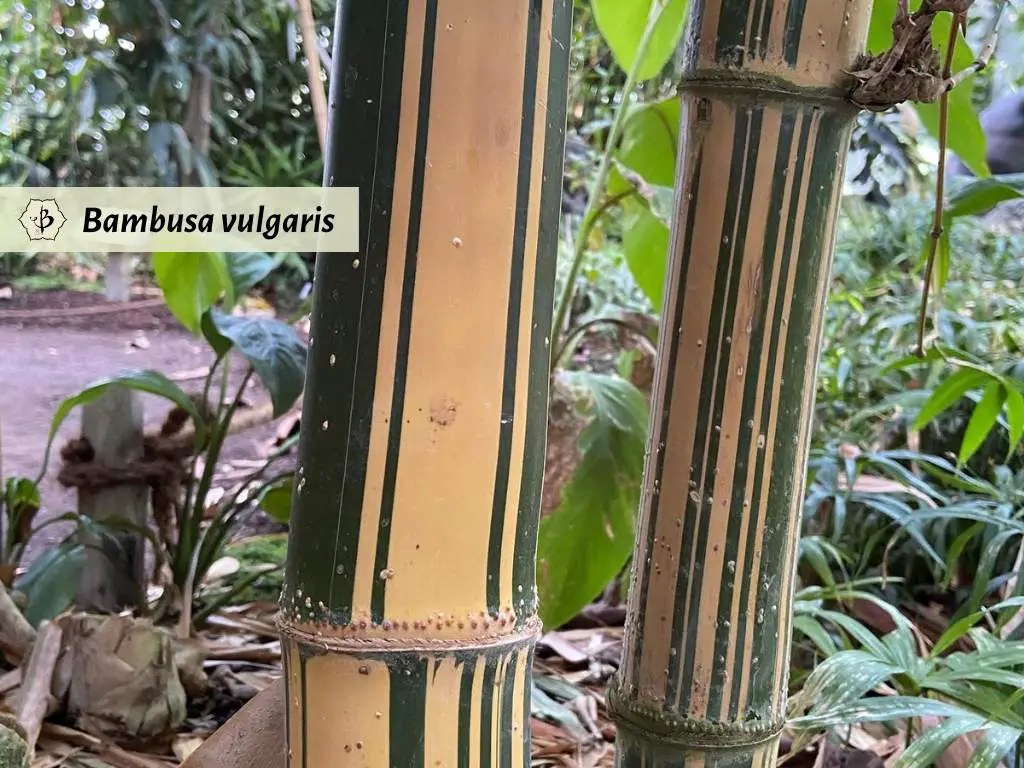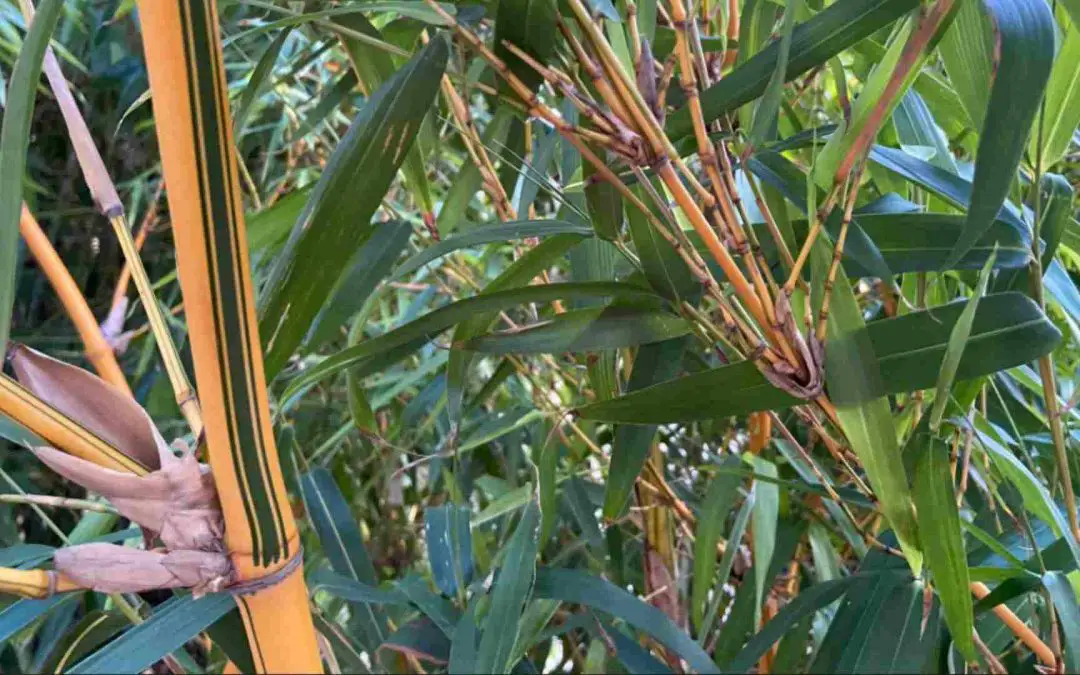Bambusa vulgaris ‘Vittata’ is a common variety of a common species. Bambusa vulgaris literally translates to “common bamboo”. A prolific plant through the tropical regions of Asia, Africa and Latin America, we can divide the variants of vulgaris into two types, green vulgaris and yellow vulgaris. The yellow variety, sometimes called golden bamboo, also has irregular green stripes, and for that reason is also called painted bamboo.
Characteristics of Bambusa vulgaris ‘Vittata’
Widespread and growing wild all over the tropics, Bambusa vulgaris ‘Vittata’ is one of the easiest species to recognize. The bold yellow culms stand out in a crowded jungle, and the green stripes, occurring on alternating sides of the internodes, are the tell-tale marker.

Like other species of Bambusa, Vittata has many branches growing out of each nodal joint, and frequently one dominant branch. The branching starts at the lowest nodes, making for a dense and somewhat chaotic thicket of stems and lateral branches.
The culms of Vittata usually grow up to about about 3 inches in diameter, or slightly more. In favorable conditions, they can grow 30 or 40 feet tall. However, the poles are not perfectly straight, but instead the often have a subtle zig-zag. Therefore, this bamboo is not best suited for building and construction. Although it is quite strong with very thick culm walls. This results in large amounts of biomass, making Vittata a good candidate for things like charcoal or biochar.

Distribution of Bambusa vulgaris ‘Vittata’
Green vulgaris and yellow vulgaris both originated in southern China, most likely, but at this point, it’s hard to know exactly. Vittata now grows all over Africa and Latin America, as well as the Pacific islands and in the Caribbean. In some areas, it outnumbers green vulgaris, which is equally widespread. But in other areas, the green variety is more common.
The best theory for Vittata’s wide distribution is that the Spanish explorers brought it on their ships back in the glory days of exploration and great navigation. Planting for erosion control on river backs, as a natural barrier, or for a building material, vulgaris soon ended up in every balmy corner of the globe. But mysteriously, there’s no clear historical record of the Spanish conquistadors making extensive use of bamboo for building.
As tropical bamboo, Vulgaris and Vittata will not do well in climates with freezing winters. It will only tolerate minimal frost a few nights of the year.

Propagating Painted Bamboo
The other secret to Vittata’s success has to do with its great ease of propagation. Like most tropical, clumping bamboo, the most effective way to propagate vulgaris is by taking culm cuttings. Normally the cutting is taken from a stem or branch, being careful to include at least one nodal joint on each segment. Then the cutting is buried halfway in the ground, either horizontally or vertically.
This strategy is typical for Bambusa and other tropical bamboo. The difference with vulgaris is that you’ll probably get a 99% success rate with your cuttings. In some cases, the cutting can just be dropped on the ground and ignored, and a new bamboo plant will take root within a matter of weeks or months. This is basically how the species has proliferated in the wild.
Another interesting but less common method is to produce aerial cuttings, as in the image below. This technique is well described in our article on propagation.

Uses for Bambusa vulgaris ‘Vittata’
Vittata is a relatively large and interesting specimen to look at, but it is not the most useful variety of bamboo to work with. As a building material, the culms are not quite straight enough to create a proper, permanent structure. However, they do have a good size and wall thickness, making them quite strong. So for something simple and temporary, Vittata is sometimes the best option. Also because it is so widely available in many areas.
Keep in mind, the stripes will fade once the bamboo poles are dried. So that feature will not be carried over into any products or structures made from Vittata or any other stripe bamboo species. Also, because it takes root so easily, you have to be careful when building. It can happen that a simple bamboo shed made from Bambusa vulgaris, when not thoroughly dried and treated, will establish new roots. Next thing you know, you have fresh branches growing out of the walls and beams.
Also, the fibers of Vittata are not perfectly straight the way you find in Moso bamboo for example, so products like toothpicks also do not work perfectly well. Still, the thick culms and thick walls are loaded with biomass, so this species can be used for pulp, to make paper products, or charcoal, which is a hot commodity in the global south.

Vulgaris bamboo projects around the world
Through my bamboo consulting work, I’ve had the pleasure of meeting and speaking with numerous bamboo entreprenuers and enthusiasts who have different projects with Bambusa vulgaris. While many bamboo aficionados consider this species something of weed, much can be done with it.
In Ghana, the Good Roll processes about 100 tons of vulgaris a day to make pulp for toilet paper. They are in the process of expanding their operations to open more factories in 2025, and will sell their pulp for other applications, like packaging paper, etc. It seems that they have overcome the logistical challenge of harvesting vulgaris from the wild, which is not easy as it grows in dense jungles, steep river beds, and snake-infested clumps.
In Puerto Rico, Bio-Restorative is clearing the waterways and turning all the invasive Vulgaris into biochar. This project helps restore the native habitat of the island while also producing a rich, valuable soil additive.
In East Africa, including Kenya and Uganda, women sometimes harvest the shoots and cook up a creamy soup from vulgaris. Many advise against harvesting the shoots of vulgaris for eating, but they need to be boiled, similar to cassava. It’s also recommended to harvest during the wet season when the starch content is higher. The shoots are more bitter in the dry season.
In Zimbabwe, Rowen the “Bambooprenuer” has tried making toothpicks from vulgaris, but the fibers aren’t straight enough, so he gets too many splinters. Now he uses Oxytenanthera abyssinica instead.
Related Reading
To learn more, take a look at these related articles:
FEATURE IMAGE: Bambusa vulgaris ‘Vittata’, or Painted Bamboo, in a French greenhouse. Photo by Fred Hornaday.

























